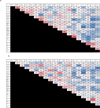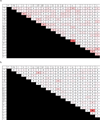The role of allograph representations in font-invariant letter identification
- PMID: 28368166
- PMCID: PMC5481478
- DOI: 10.1037/xhp0000384
The role of allograph representations in font-invariant letter identification
Abstract
The literate brain must contend with countless font variants for any given letter. How does the visual system handle such variability? One proposed solution posits stored structural descriptions of basic letter shapes that are abstract enough to deal with the many possible font variations of each letter. These font-invariant representations, referred to as allographs in this paper, while frequently posited, have seldom been empirically evaluated. The research reported here helps to address this gap with 2 experiments that examine the possible influence of allograph representations on visual letter processing. In these experiments, participants respond to pairs of letters presented in an atypical font in 2 tasks-visual similarity judgments (Experiment 1) and same/different decisions (Experiment 2). By using representational similarity analysis (RSA) in conjunction with linear mixed effect models (LMEM; RSA-LMEM) we show that the similarity structure of the responses to the atypical font is influenced by the predicted similarity structure of allograph representations even after accounting for font-specific visual shape similarity. Similarity due to symbolic (abstract) identity, name, and motor representations of letters are also taken into account providing compelling evidence for the unique influence of allograph representations in these tasks. These results provide support for the role of allograph representations in achieving font-invariant letter identification. (PsycINFO Database Record
(c) 2017 APA, all rights reserved).
Figures








Similar articles
-
Allograph priming is based on abstract letter identities: Evidence from Japanese kana.J Exp Psychol Learn Mem Cogn. 2019 Jan;45(1):183-190. doi: 10.1037/xlm0000563. Epub 2018 Apr 23. J Exp Psychol Learn Mem Cogn. 2019. PMID: 29683709
-
Visual knowledge underlying letter perception: font-specific, schematic tuning.J Exp Psychol Hum Percept Perform. 1987 May;13(2):267-78. doi: 10.1037//0096-1523.13.2.267. J Exp Psychol Hum Percept Perform. 1987. PMID: 2953856
-
A New Font, Specifically Designed for Peripheral Vision, Improves Peripheral Letter and Word Recognition, but Not Eye-Mediated Reading Performance.PLoS One. 2016 Apr 13;11(4):e0152506. doi: 10.1371/journal.pone.0152506. eCollection 2016. PLoS One. 2016. PMID: 27074013 Free PMC article.
-
Letter processing and font information during reading: beyond distinctiveness, where vision meets design.Atten Percept Psychophys. 2012 Jan;74(1):132-45. doi: 10.3758/s13414-011-0220-9. Atten Percept Psychophys. 2012. PMID: 22012239 Review.
-
Alphabetic letter identification: effects of perceivability, similarity, and bias.Acta Psychol (Amst). 2012 Jan;139(1):19-37. doi: 10.1016/j.actpsy.2011.09.014. Epub 2011 Oct 26. Acta Psychol (Amst). 2012. PMID: 22036587 Free PMC article. Review.
Cited by
-
Parafoveal letter identification in Russian: Confusion matrices based on error rates.Behav Res Methods. 2024 Dec;56(8):8567-8587. doi: 10.3758/s13428-024-02492-3. Epub 2024 Sep 11. Behav Res Methods. 2024. PMID: 39261445
-
The Effects of Handwriting Experience on Literacy Learning.Psychol Sci. 2021 Jul;32(7):1086-1103. doi: 10.1177/0956797621993111. Epub 2021 Jun 29. Psychol Sci. 2021. PMID: 34184564 Free PMC article.
References
-
- Baayen RH, Milin P. Analyzing reaction times. International Journal of Psychological Research. 2010;3(2):12–28. http://doi.org/10.1287/mksc.12.4.395. - DOI
-
- Barsalou LW. Grounded cognition. Annual Review of Psychology. 2008;59:617–645. http://doi.org/10.1146/annurev.psych.59.103006.093639. - DOI - PubMed
-
- Barton K. MuMIn: Multi-model inference. R package version 1.15.6. 2016 https://CRAN.R-project.org/package=MuMIn.
-
- Bates D, Mächler M, Bolker B, Walker S. Fitting Linear Mixed-Effects Models using lme4. Journal of Statistical Software. 2015;67(1):1–48.
-
- Besner D, Coltheart M, Davelaar E. Basic processes in reading: Computation of abstract letter identities. Canadian Journal of Psychology. 1984;38(1):126–134. - PubMed
MeSH terms
Grants and funding
LinkOut - more resources
Full Text Sources
Other Literature Sources
Medical
Miscellaneous

